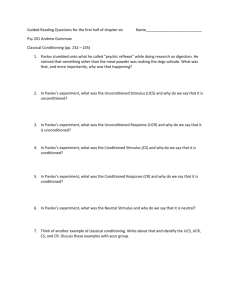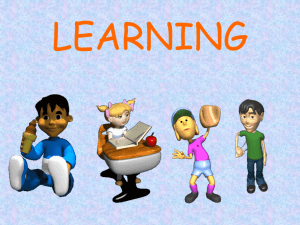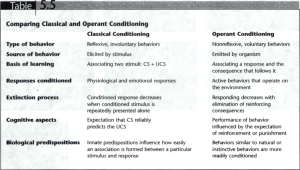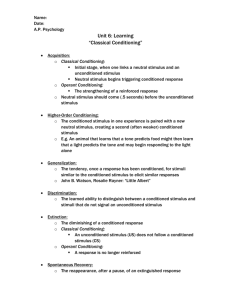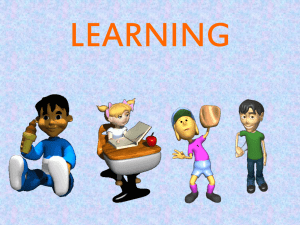Chapter 9: Learning
advertisement
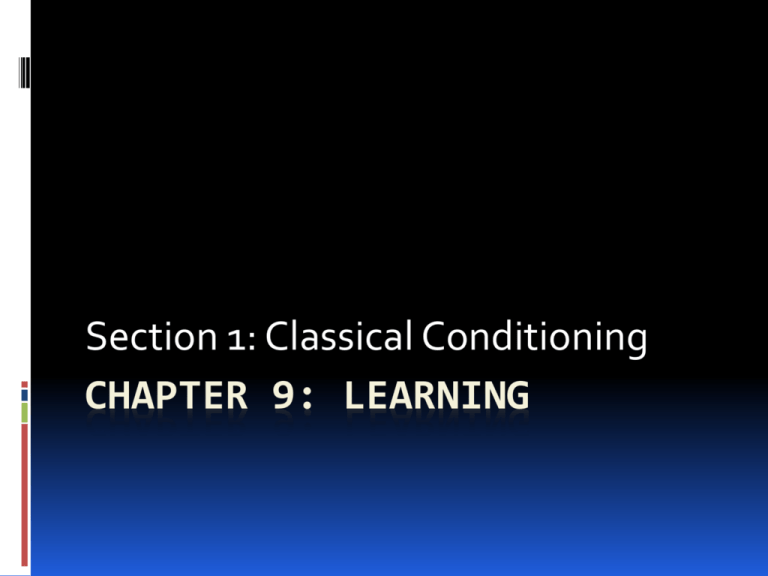
Section 1: Classical Conditioning CHAPTER 9: LEARNING PDN: Read page 284-285 What is the best way to learn? Learning: A relatively permanent change in behavior (or behavioral potential) due to experience. Experience is the greatest teacher Affect how the person is likely to act in the future Behaviorism: An approach to psychology that emphasizes the study of observable behavior and the role of the environment as a determinant of behavior. Focus of conditioning- involves associations between environmental stimuli & responses Two types Classical Conditioning Operant Conditioning Classical Conditioning Ivan Pavlov was studying the salivation in dogs Eventually the dogs would start salivating just when brought to the laboratory & saw an empty bowl Conditioned reflex because it depended on environmental conditions Pavlov’s Apparatus Harness and fistula (mouth tube) help keep dog in a consistent position and gather uncontaminated saliva samples They do not cause the dog discomfort 9-6 New Reflexes from Old Original salivary reflex- Unconditioned response (UCR) Food- unconditioned stimulus (UCS) UCS- any event or thing that elicits a response automatically or reflexively UCR- response that is automatically produced Learning occurs when a neutral stimulus becomes the conditioned stimulus (CS) that is paired with a UCS A CS elicits a CR, which is usually similar to the original unlearned one Classical Conditioning: The process by which a previously neutral stimulus acquires the capacity to elicit a response through association with a stimulus that already elicits a similar or related response. 9-9 Terms Conditioned Stimulus: An initially neutral stimulus that comes to elicit a conditioned response after being associated with an unconditioned stimulus. Conditioned Response: A response that is elicited by a conditioned stimulus it occurs after the conditioned stimulus is associated with an unconditioned stimulus. Principles of Classical Conditioning Occurs in all species Acquisition A neutral stimulus that is consistently followed by an unconditioned stimulus will become a conditioned stimulus. Extinction The weakening & eventual disappearance of a learned response It occurs when the conditioned stimulus is no longer paired with the unconditioned stimulus. Wade and Tavris © 2005 Prentice Hall 9-12 Spontaneous recovery- explains why completely eliminating a CR usually requires more than one extinction session Higher Order Conditioning A procedure in which a neutral stimulus becomes a conditioned stimulus through association with an already established conditioned stimulus. 9-14 May explain why some words trigger emotional response in us Ex: Birthdays May contribute to the formation of prejudices Dumb Pollacks Generalization & Discrimination Stimulus Generalization: After conditioning, the tendency to respond to a stimulus that resembles one involved in the original conditioning. Ex: sounds 916 Stimulus Discrimination: The tendency to respond differently to two or more similar stimuli. Ex: difference between sounds What is actually learned in Classical Conditioning? To be most effective, the stimulus to be conditioned should precede the UCS The CS becomes a signal for the UCS To become a CS, the neutral stimulus, must reliably signal or predict the UCS Examples Review

